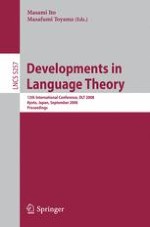This book constitutes the refereed proceedings of the 12th International Conference on Developments in Language Theory, DLT 2008, held in Kyoto, Japan, September 2008. The 36 revised full papers presented together with 6 invited papers were carefully reviewed and selected from 102 submissions. All important issues in language theory are addressed including grammars, acceptors and transducers for words, trees and graphs; algebraic theories of automata; algorithmic, combinatorial and algebraic properties of words and languages; variable length codes; symbolic dynamics; cellular automata; polyominoes and multidimensional patterns; decidability questions; image manipulation and compression; efficient text algorithms; relationships to cryptography, concurrency, complexity theory and logic; bio-inspired computing; quantum computing.
